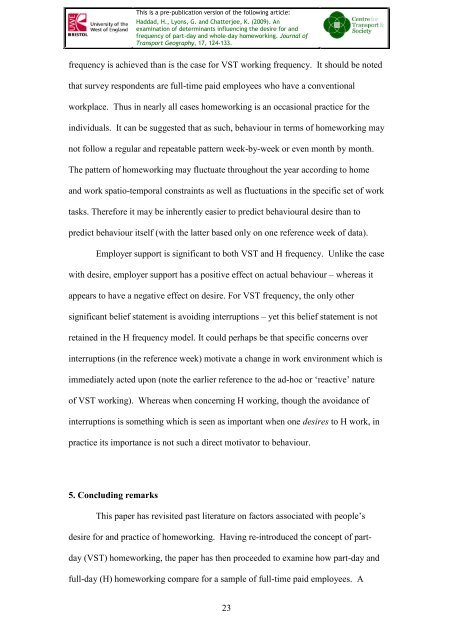Haddad, H. , Lyons, G. and Chatterjee, K. (2009) - UWE Research ...
Haddad, H. , Lyons, G. and Chatterjee, K. (2009) - UWE Research ...
Haddad, H. , Lyons, G. and Chatterjee, K. (2009) - UWE Research ...
Create successful ePaper yourself
Turn your PDF publications into a flip-book with our unique Google optimized e-Paper software.
This is a pre-publication version of the following article:<br />
<strong>Haddad</strong>, H., <strong>Lyons</strong>, G. <strong>and</strong> <strong>Chatterjee</strong>, K. (<strong>2009</strong>). An<br />
examination of determinants influencing the desire for <strong>and</strong><br />
frequency of part-day <strong>and</strong> whole-day homeworking. Journal of<br />
Transport Geography, 17, 124-133.<br />
frequency is achieved than is the case for VST working frequency. It should be noted<br />
that survey respondents are full-time paid employees who have a conventional<br />
workplace. Thus in nearly all cases homeworking is an occasional practice for the<br />
individuals. It can be suggested that as such, behaviour in terms of homeworking may<br />
not follow a regular <strong>and</strong> repeatable pattern week-by-week or even month by month.<br />
The pattern of homeworking may fluctuate throughout the year according to home<br />
<strong>and</strong> work spatio-temporal constraints as well as fluctuations in the specific set of work<br />
tasks. Therefore it may be inherently easier to predict behavioural desire than to<br />
predict behaviour itself (with the latter based only on one reference week of data).<br />
Employer support is significant to both VST <strong>and</strong> H frequency. Unlike the case<br />
with desire, employer support has a positive effect on actual behaviour – whereas it<br />
appears to have a negative effect on desire. For VST frequency, the only other<br />
significant belief statement is avoiding interruptions – yet this belief statement is not<br />
retained in the H frequency model. It could perhaps be that specific concerns over<br />
interruptions (in the reference week) motivate a change in work environment which is<br />
immediately acted upon (note the earlier reference to the ad-hoc or „reactive‟ nature<br />
of VST working). Whereas when concerning H working, though the avoidance of<br />
interruptions is something which is seen as important when one desires to H work, in<br />
practice its importance is not such a direct motivator to behaviour.<br />
5. Concluding remarks<br />
This paper has revisited past literature on factors associated with people‟s<br />
desire for <strong>and</strong> practice of homeworking. Having re-introduced the concept of part-<br />
day (VST) homeworking, the paper has then proceeded to examine how part-day <strong>and</strong><br />
full-day (H) homeworking compare for a sample of full-time paid employees. A<br />
23

















